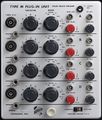M
The Type M is a four-channel plug-in for 500-series scopes. Early versions had UHF connectors for the inputs. Later versions have BNC connectors for the inputs. The risetime is 17 nanoseconds, bandwidth is DC to 20MHz. Maximum sensitivity is 20mV/div. Each channel can be AC or DC coupled, inverted or straight, or disabled entirely. The enabled channels can operate in CHOP or ALT mode.
Each input goes through a step attenuator, is clamped by a neon bulb, and then is fed to the grid of a cathode follower made with a 7586 Nuvistor tube. Next, the signal goes to a PNP differential amplifier. Diodes in series with the collector signal of this differential amplifier are used for input channel switching. An internal differential signal bus connects the switched outputs of each of the input channels and feeds the signal to the output amplifier, which drives the signal output, pins 1 and 3 of the plug-in connector. The output amplifier is two 12AU6 pentodes connected as a differential amplifier, followed by a 12AT7 dual triode acting as a cathode follower to drive the output with a relatively low impedance.
Type M was introduced between 1960 and 1962, along with Types N, Q, S, and Z, all partly transistorized.
-
Front view.
-
Right view
-
Left view.


